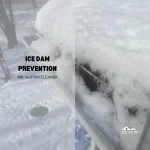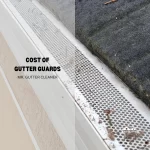Gutters play a crucial role in home maintenance, channeling water away from the structure to protect it from damage. Understanding the function and importance of gutters is the first step in recognizing the issues that can arise when they become clogged or blocked.
Clogged gutters, filled with debris such as leaves and twigs, hinder water flow, leading to potential overflow.
Blocked gutters, on the other hand, are obstructed by external factors like nests or accumulated sediment, completely stopping water passage.
Both situations pose risks to a home’s integrity, including water damage to foundations, walls, and landscaping.
Regular gutter maintenance is essential to prevent these issues, emphasizing the need for homeowners to distinguish between clogged and blocked gutters to apply appropriate solutions.
Neglecting gutter care can lead to severe consequences, such as roof damage, basement flooding, and the compromise of the home’s structural integrity.
Through regular cleaning, installation of gutter guards, and professional inspections, homeowners can mitigate these risks. Advances in gutter design and maintenance technology offer additional tools for ensuring gutters remain clear and functional, safeguarding the home against the many problems that poor gutter maintenance can cause. This foundational knowledge equips homeowners with the understanding necessary to maintain their gutters effectively, contributing to overall home health and longevity.
Understanding Gutters and Their Importance
Gutters play a pivotal role in home maintenance, channeling water away from the building to protect its structural integrity. They safeguard the foundation, prevent landscaping erosion, and minimize the risk of basement flooding. Effective gutters are indispensable for maintaining a home’s condition and preventing costly water damage.
What Are Gutters and Why Are They Essential?
Gutters are designed to collect and channel rainwater from the roof to downspouts, which then safely divert water away from the home’s foundation. This process is crucial for protecting the structure from water damage, soil erosion around the foundation, and preventing water from infiltrating basements or crawl spaces. Gutters also play a role in maintaining the exterior appearance and landscaping of a home, making them essential for overall home maintenance.
Table of Contents:
How Do Gutters Work?
Gutters work by capturing rainwater that falls on the roof and funneling it to downspouts positioned around the home’s perimeter. These downspouts then discharge the water at a safe distance from the foundation, ensuring that the soil remains stable and water does not accumulate near the structure. Proper gutter installation and maintenance are key to ensuring that gutters perform effectively, preventing water from spilling over and causing damage. Regular cleaning and inspection of gutters are vital to avoid clogs that can impede their functionality and lead to water-related issues.
Identifying Gutter Issues
Recognizing the signs of gutter problems is crucial for maintaining a home’s structural integrity and preventing water damage. Issues with gutters can manifest in various ways, depending on whether they are clogged or blocked, each presenting unique challenges that require timely attention.
What Does It Mean When Gutters Are Clogged?
Clogged gutters are a common issue that occurs when leaves, twigs, and other debris accumulate in the gutter, obstructing the flow of water. This blockage prevents water from moving freely through the gutter system, leading to overflows that can result in water damage to the roof, siding, and foundation of the home. Regular cleaning is essential to prevent clogging and ensure that gutters can perform their intended function.
What Does It Mean When Gutters Are Blocked?
Gutters become blocked when external factors, such as bird nests or accumulated ice, create a physical barrier that stops water flow entirely. Unlike clogs, which are caused by debris within the gutter, blocks often occur at the downspouts or gutter outlets, leading to water backing up and potentially seeping into the home. Addressing blockages quickly is key to avoiding serious water damage.
Common Causes of Clogged and Blocked Gutters
The most frequent causes of gutter clogs and blocks include fallen leaves, branches, and other natural debris, as well as man-made obstructions like balls or bird nests. Seasonal changes, particularly autumn when leaves fall, and spring when trees release seeds, significantly contribute to gutter clogs. Additionally, lack of regular maintenance is a primary factor that exacerbates the risk of both clogged and blocked gutters. Understanding these causes is the first step toward effective prevention and maintenance strategies.
Consequences of Neglecting Gutter Maintenance
Neglecting gutter maintenance can lead to a range of problems, significantly impacting home maintenance and potentially causing extensive damage. Understanding these consequences is crucial for homeowners to prioritize regular gutter care.
Impact on Home Maintenance
When gutters are not regularly cleaned or inspected, water can overflow and seep into areas it shouldn’t, leading to issues such as soil erosion around the foundation, damaged landscaping, and weakened structural integrity. Over time, persistent water exposure can deteriorate building materials, including siding, roofing, and foundation concrete, necessitating costly repairs.
Potential Home Damages from Improper Gutter Care
The damages resulting from neglected gutters extend beyond mere water accumulation; they can cause serious structural problems. Water infiltration can lead to mold and mildew growth inside walls and basements, creating health hazards and additional repair expenses. Roof damage, including rot and leaks, becomes a significant risk as water backs up under shingles. Furthermore, water pooling around the foundation can lead to cracks and instability, posing long-term risks to the home’s safety and value.
Distinguishing Between Clogged and Blocked Gutters
Understanding the difference between clogged and blocked gutters is essential for applying the correct maintenance solutions. Each condition affects water flow differently, leading to unique sets of problems that require targeted responses.
Key Differences in Symptoms
Clogged gutters typically exhibit signs such as water spilling over the edges during rainfall, the presence of visible debris like leaves and twigs sticking out of the gutter, and the gutter system sagging or pulling away from the house due to the weight of the accumulated debris. Blocked gutters, however, often result in no visible water flow from the downspout during rainstorms, or water visibly backing up and overflowing at the point of blockage, indicating a complete stoppage of water flow.
Assessing the Severity of Gutter Problems
To effectively assess the severity of gutter problems, homeowners should look for indicators such as water damage to the home’s exterior walls, foundation erosion, and signs of mold or mildew on the house’s siding or interior. Frequent overflows, especially in areas with no visible clogs, suggest blockages that may be located in the downspouts or underground drain systems. Early detection and assessment of these issues are critical to preventing minor problems from escalating into major damages, necessitating professional evaluation and intervention.
Preventative Measures and Solutions
Implementing preventative measures and finding effective solutions for gutter maintenance are key to avoiding the issues associated with clogged or blocked gutters. By taking proactive steps, homeowners can ensure their gutter systems function optimally, protecting their homes from water-related damages.
Regular Maintenance Tips for Gutters
Regular maintenance is crucial for keeping gutters clear and operational. This includes cleaning gutters at least twice a year, typically in the spring and fall, to remove leaves, twigs, and other debris. Inspecting gutters for signs of wear, damage, or misalignment and making necessary repairs promptly can prevent future clogs and blocks. Additionally, ensuring downspouts are clear and extend far enough away from the foundation will help direct water properly away from the home.
How to Effectively Clean Your Gutters
Effective gutter cleaning involves removing debris from the gutters and downspouts, flushing them with water to check for proper flow and blockages, and inspecting the gutter system for any signs of damage. Using tools such as gutter scoops, garden hoses, and possibly a plumber’s snake for tougher clogs in downspouts can make the cleaning process more efficient. Safety measures, such as using a sturdy ladder and wearing gloves, cannot be overstated.
Solutions for Preventing Future Clogs and Blocks
To prevent future gutter clogs and blocks, homeowners can install gutter guards, which help keep debris out while allowing water to flow through. Regular inspections, especially after severe weather events, can catch and address minor issues before they become significant problems. Considering professional gutter cleaning services can also be a viable option for those unable to perform maintenance themselves, ensuring gutters remain clear and functional throughout the year.
Professional Intervention and When It’s Needed
Sometimes, despite best efforts at maintenance, professional intervention becomes necessary to address gutter issues effectively. Understanding when to seek professional help can save homeowners from further damage and potentially costly repairs.
Signs That You Need Professional Help
Several signs indicate the need for professional gutter cleaning or repair services. These include persistent clogs that cannot be cleared with standard home cleaning methods, signs of water damage to the home’s exterior indicating poor gutter performance, and the presence of pests or animals nesting in the gutters.
Additionally, if the gutters are sagging, pulling away from the house, or visibly damaged, it’s time to call in professionals who have the tools and expertise to safely and effectively remedy the situation.
Choosing the Right Service for Gutter Maintenance
Selecting the right professional service for gutter maintenance involves considering several factors. Look for services with positive reviews, proper licensing and insurance, and a track record of reliable and thorough work. It’s also beneficial to choose companies that offer comprehensive gutter maintenance packages, including cleaning, inspection, and repair, to ensure all potential issues are addressed. Getting quotes from multiple providers can help homeowners find the best service for their needs and budget.
Innovations in Gutter Design and Maintenance
Advancements in gutter design and maintenance technologies offer homeowners improved solutions for protecting their homes from water damage. These innovations not only enhance the functionality of gutter systems but also reduce the need for frequent maintenance.
Advances in Gutter Technology
Recent advances in gutter technology include the development of more durable materials, such as copper and stainless steel, that withstand the elements better and last longer than traditional aluminum. Additionally, seamless gutter systems reduce the likelihood of leaks. Smart gutter systems equipped with sensors can detect clogs and alert homeowners before issues escalate, and heated gutters prevent ice blockages in colder climates.
The Role of Gutter Guards and Other Accessories
Gutter guards play a crucial role in reducing maintenance by preventing leaves and debris from entering the gutter while allowing water to flow through. There are various types of gutter guards, including mesh screens, foam inserts, and surface tension helmets, each with its advantages and suitability for different situations. Other accessories, like downspout extensions and splash blocks, further enhance water management by directing it away from the home’s foundation, reducing erosion and water damage risk.


